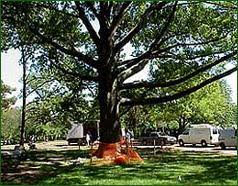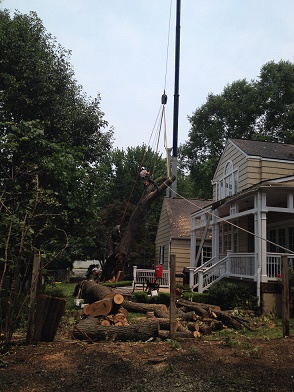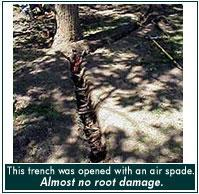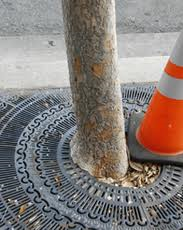Urban development and construction are two factors which can provide a challenging situation for trees. As the need grows for more space to accommodate homes and commercial development, tree health must be reevaluated.
- Building with Trees
- Digging and Tree Roots
- Compaction
Trees can often be seriously injured or even totally removed when new construction occurs. In many cases this loss and damage could have been minimized by early planning, before the bulldozers move in.
There are numerous factors that affect a tree's growth and longevity which must be considered before, during and after construction activity. Probably the most consistent and significant injury is to the root system of trees.
Soil compaction, soil moisture, soil temperature, root loss, and grade alterations can adversely affect trees in the short and long-term. Proper watering, pruning and fertilization practices are usually necessary if many trees are to overcome the effects of construction damage.
Building with Trees
Call us before the construction process starts.
“Would a man rather have a person explain how to use a tool before he cuts off his leg or help him after the fact”
Those of us who live in or near the city or suburbs know that new housing additions are popping up everywhere. More often than not, this means trees are being cut down. However, the conscientious builder or property owner may take measures to preserve valuable trees during construction and avoid any construction damage. Hiring a certified arborist to work with your contractor/builder is a great way to save trees and increase the value of your property.
Time and time again, we, as arborists, find ourselves being called post-construction and post-excavation to try to “save” a tree that was damaged in the building process. Unfortunately, once damage is done it is often too late for even the experts to save the tree. Arborists should be involved during the architectural stage for the best preservation and survival of the trees.
Construction damage is a tricky situation because the detrimental results are often masked at first. It may take up to ten years before a tree damaged by construction finally fails. Often, a new homeowner is thrilled at the beautiful trees on their property. Then, after a few years, they wonder why their once beautiful trees are declining. Needless to say, this can be very frustrating for the homeowner as they may have to pay for expensive removals which decrease the value of their property.
Hendrickson Tree Care Company does offer consulting services. We will work closely with the homeowner and contractor to preserve the valuable trees on your property and take preventative measures for the upkeep of these assets.
Click here for more information on avoiding tree damage during construction.
Digging and Tree Roots
Surprisingly, most of the tree’s root system is located in the top 12-18 inches of soil. What this means is that you don’t have to dig very deep to damage the root system of a tree. The roots can also spread out two to four times the diameter of the tree’s crown from the stem (trunk). The roots grow this extensively in order to obtain water, minerals and oxygen from the soil.
There are numerous ways to injure tree roots and subsequently stress trees. Mechanical injury through digging and trenching is one such way to damage tree roots. Excavation is a tricky process and prior to digging around a tree a certified arborist should be involved.
Once the arborist has safely identified and marked underground utilities, excavation around trees can begin. The arborist can determine the optimal places for digging and trenching, while preserving the majority of the root system. The age of the tree needs to be considered in addition to the percentage of root system affected. certified arborists also have the appropriate training and equipment for this type of work. This is yet another reason to obtain an arborist’s expertise early on in the planning phase.
Compaction
 Soil compaction is a situation seen in many landscapes. Trees on many different properties will undergo compaction to some degree during construction. Unfortunately, the negative results of compaction may not be seen immediately, and could result in long-term stress.
Soil compaction is a situation seen in many landscapes. Trees on many different properties will undergo compaction to some degree during construction. Unfortunately, the negative results of compaction may not be seen immediately, and could result in long-term stress.
A high volume of traffic above the root system of a tree will cause compaction. There are varying degrees of damage related to the type of traffic: foot, vehicular and especially, heavy construction machinery. Naturally, it is best to factor tree care into design considerations to avoid compaction while building and landscaping but in reality, this does not always happen.
What is actually happening to the soil?
Soil typically has large holes or spaces called macropores. Applying pressure and force to the soil eradicates these macropores. They are either squeezed into micropores or eliminated entirely, increasing the density of the soil. When the density reaches a high enough point, the roots are unable to penetrate the soil. Less oxygen is available to the root system, carbon dioxide does not easily move away from roots, and water retention is reduced. As a result, the tree becomes more susceptible to problems such as: an unsightly crown, decay, root rot, diseases, and pests. Trees have varying levels of tolerance to soil compaction, and the stress effects are long-term in many cases. For instance, trees that underwent landscaping stress six years ago could just now show initial signs of the resulting stress.
What can I do to help prolong the life of my compacted trees?
Before beginning any compaction treatment, it is a good idea to contact a certified arborist to discuss options. Arborists also have the appropriate tools and equipment needed for treatment. Fertilization may be needed. If the damage is severe, soil replacement and vertical mulching measures may be taken. However, even without these treatments, you can at least apply a mulch layer, between 2-4 inches thick from near the trunk (not up against it) extending out as far as possible. This will benefit by preserving moisture. In the long run it will protect against further compaction.
It is important to remember that a certified arborist is trained to identify soil compaction and suggest beneficial treatment. When building around trees it is also important to involve an arborist in the contracting process. An arborist at Hendrickson Tree Care Company can advise as needed to prolong the life of your trees and increase the value of your property.
